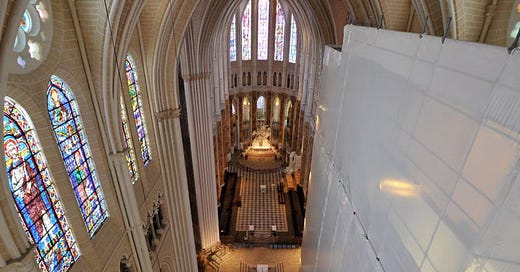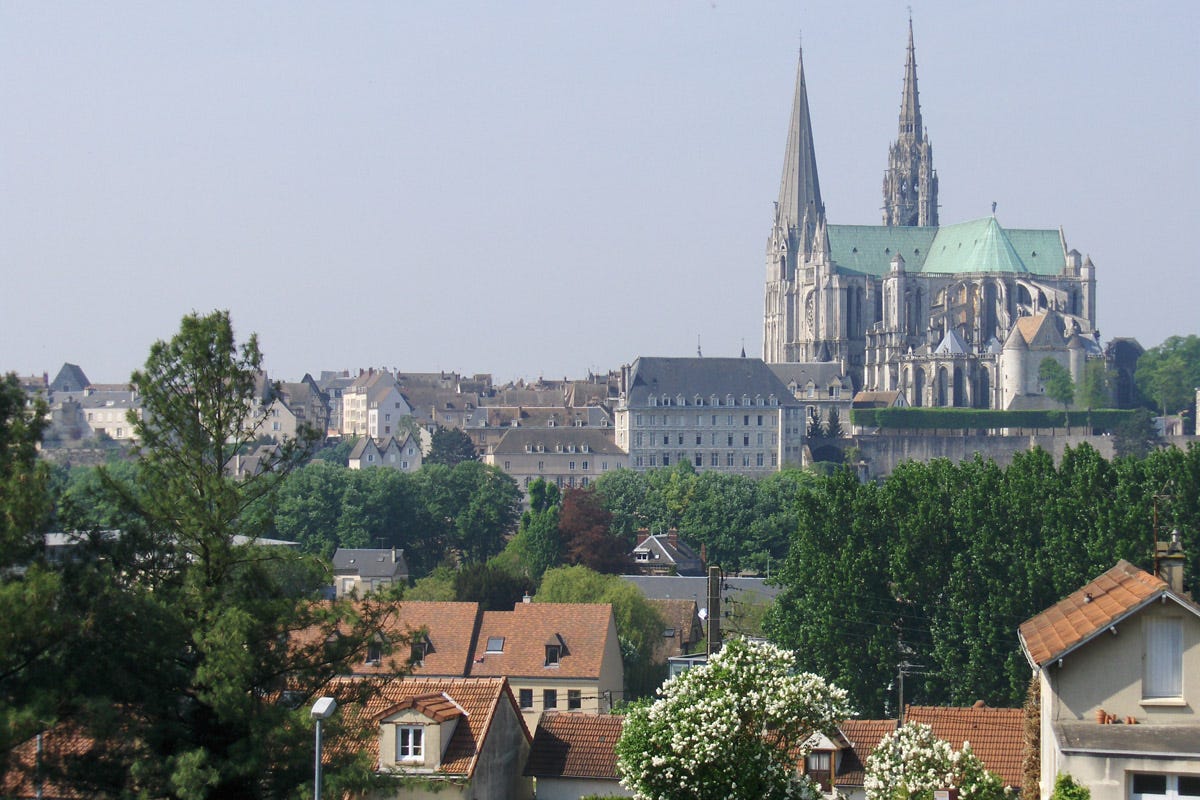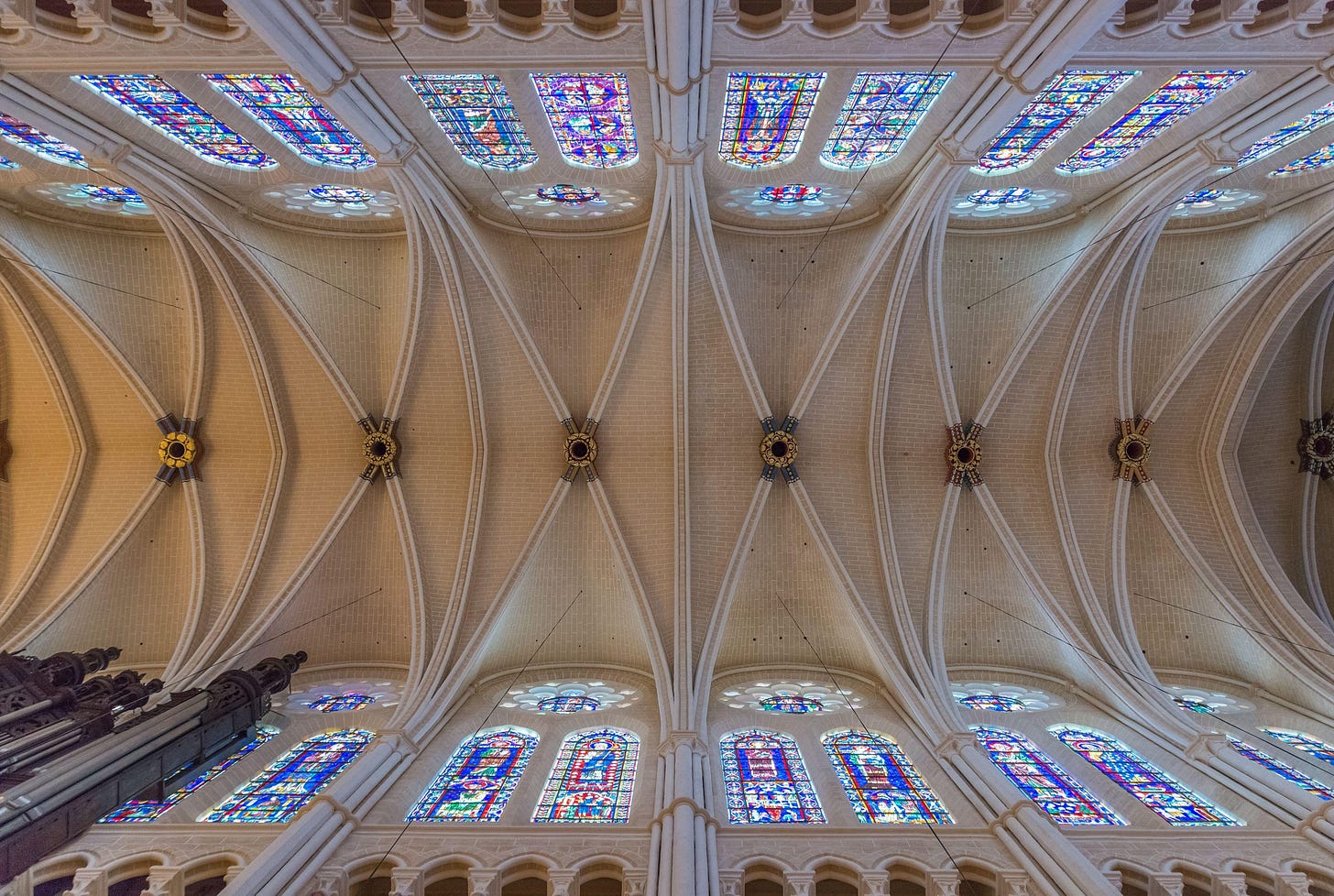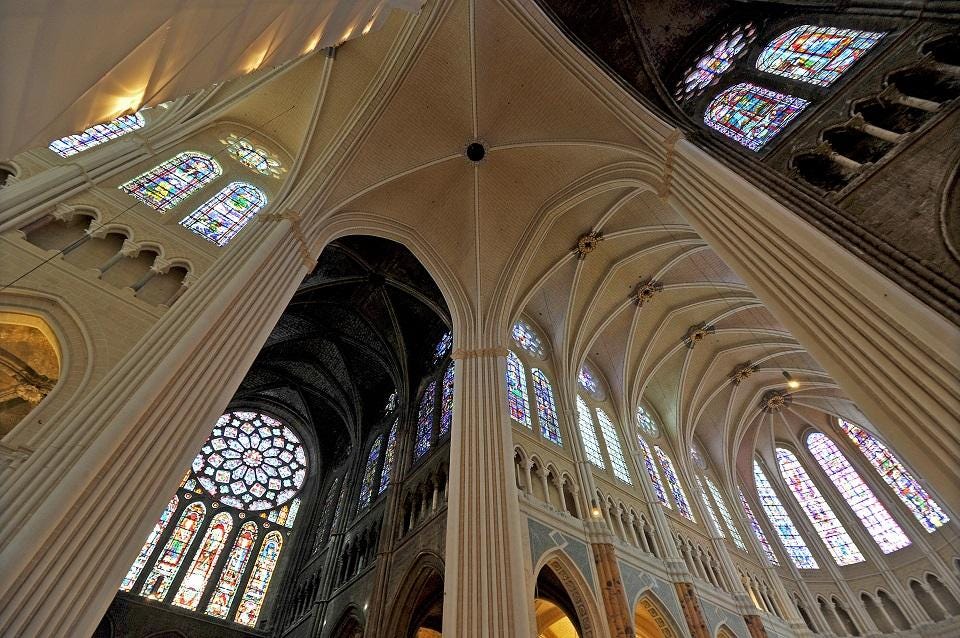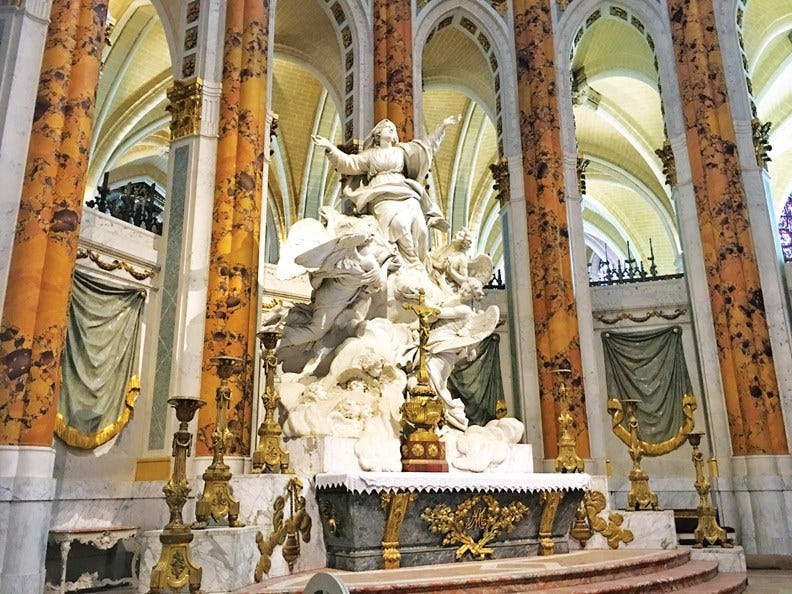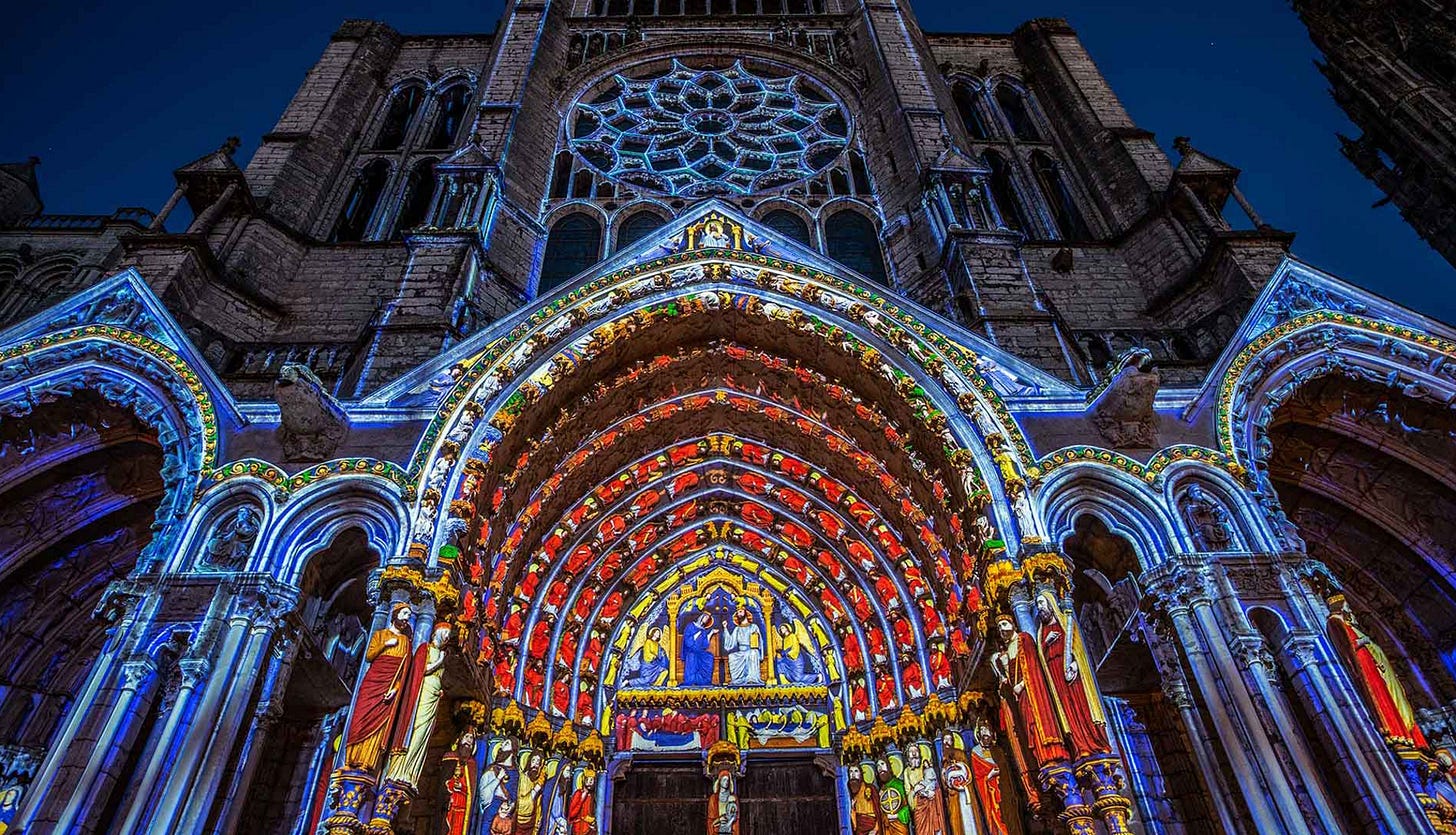This article was written in 2015, when the comprehensive desecration of Chartres Cathedral was still in progress. I am publishing it now on my Substack, as promised in my previous post, so as to provide the latter with further context and background.
1
Even in a world that has accustomed us to barbarism of every kind, it seems like there will always be news stories capable of leaving one in a state of appalled disbelief. Recently I experienced that kind of disbelief on realising what is being done to Chartres Cathedral, one of the greatest spiritual achievements of humanity, in the name of “restoring” it to its supposedly original state.
For me as for many others, the alarm was raised by Martin Filler in the New York Review, in an article entitled A Scandalous Makeover at Chartres. Earlier, in 2012, the British magazine The Spectator ran a piece called Restoration Tragedy, expressing unease at what was taking place in the great Gothic cathedral. Now in the wake of Filler’s salvo a major controversy has at last begun to brew, with a scathing polemic from Alexander Gorlin in The Huffington Post entitled simply The Destruction of Chartres Cathedral.
“As the world hurtles towards a bloodless digital future of flickering electronic screens and virtual experiences,” Gorlin’s article begins, “certain places of primal architectural power become ever more valuable as anchors of the past. Chartres Cathedral is one of the most important of these sacred places…” Now, however, it is being subject to a makeover which constitutes “cultural vandalism of the lowest order, on par with the Taliban's demolition of the Bamiyan Buddhas in Afghanistan in 2001.”
Chartres was a universally acknowledged marvel prior to this current “restoration”. And not just because the edifice as originally built represented the pinnacle of Gothic architecture in France, and arguably in all of Europe. What was also unique about it was its survival, almost intact, down through eight centuries, through the wars and revolutions that disfigured so much of France’s medieval heritage.
Even the atmospheric pollution which has taken such a toll of its sister cathedrals, built generally at the heart of large towns or cities, has been less of a problem for Chartres. Located on an ancient Druidical site 100 kms south-west of Paris, the cathedral is surrounded only by a small town of the same name, set in the rolling agricultural plains of the Beauce.
Given its well-preserved condition, not to mention the uniqueness of the edifice itself, one would have expected that any restoration work would be carried out with maximum sensitivity and minimal intervention. What we are getting instead is maximum intervention and minimal respect.
Started in 2009 under the auspices of the French Ministry of Culture, and due for completion in 2017, the current makeover is so extreme, producing something so different in appearance and atmosphere from what went before, that I believe the result will deserve nothing less than a new name. My own modest suggestion would be Euro Chartres, for reasons which will become clear towards the end of this article.
The objective of the current restoration, according to those carrying it out and supporting it, is to return the cathedral to something like its original state, as it is thought or imagined or surmised to have been in the early 13th century. That has meant removing the patina of 800 years, branded now as “grime”, from the interior of the building, and painting it fresh and bright instead.
“Chartres was all of one piece, as if carved from a single rock”, says Gorlin. “The floors are ancient stone, out of which grow the massive columns from which the ceiling flowed upwards into interlocking curving vaults. Shockingly now, instead of the patina of age that marked and mottled the thick columns and walls, the newly applied white and beige paint looks like a rundown apartment that has been painted for an upcoming real estate sale.”
Like any good estate agent, the Ministry of Culture and its team of “restorers” is keen to show off its property to prospective visitors. The combination of bright electric uplights at the top of columns shining into the vaults, together with the industrial quantities of fresh paint with which those vaults and columns have now been daubed, produces an effect of shallow, uniform brightness.
This is the kind of brightness we are all accustomed to, of course, from our office spaces, airports, shopping malls and so on. Now this is set to become the retroactive norm for those dim epochs which failed in their own time to benefit from such facilities. The restorers, or should we call them the interior decorators, have created an “authentic” 13th century experience in which electric light reigns supreme.
In order to understand the desecration this represents, we need to consider a central feature of all great religious architecture of the Middle Ages: the interplay within a building’s interior of darkness and light. Entering Chartres cathedral as it used to be, the first impression typically was of darkness relative to the exterior daylight, darkness and even disorientation, the sense of having gained access to a different dimension, and of having to find one’s bearings within it.
As the eye adjusted, however, the inner world of the building began to take shape before you. Your gaze was led instinctively upwards, guided by the awe-inspiring elevation to the subtly-gradated light filtered through the stained-glass windows, more intact here than in any other French cathedral. The cobalt blue which is their dominant tonality was made in ways we no longer understand from ground lapis lazuli imported from what is now Afghanistan. The effect was truly breathtaking. After the almost initiatic passage through darkness, one had arrived at a different world of jewelled light that was imbued with the meaning of the images through which it was filtered.
But not anymore. In the spanking new version of Chartres Cathedral currently taking shape, the sense of sacred space is effectively eliminated. This sense, which depends on a qualitative difference between within and without, is absolutely basic to medieval religious architecture. Instead now the restored windows look washed out when set within the newly painted-over walls.
Quite evidently the contrast between window light and walls is lost. Instead of the stained glass acting as a medium to produce a subtle and rich illumination, it appears now as a slightly pointless decorative pattern, shorn of its transformative magic. The point is so obvious as to be conceded even by a key member of the restoration team, quoted in an article on the makeover in Paris-Match magazine: “Michel Petit, master glazer, is still not convinced: ‘The walls are too bright. The windows lose their impact.’” And all for what?
The ostensible reason or justification, we have seen, is to restore the edifice to its “original version”, or as near as possible, producing a kind of new-old Chartres that is shorn of its evolution over time. The effect is not so different from a virtual-reality experience, a computerised remake from which the intervening centuries have simply been erased.
This is very much in line with the Hollywood notion of historical stage-set, which in turn merges into its fantasy movies. Indeed for Hollywood, history and fantasy are two categories scarcely distinguishable from each other. Euro Chartres again is faithful to this contrived aesthetic, in that its “historical” take on the matter has a distinctively “fantasy” feel about it.
(Speaking of the movies, Adrien Goetz writing in the French national daily newspaper Le Figaro last November likened the experience of Euro Chartres to watching a film with the cinema lights turned on. Yet apparently his has been the only public voice raised so far in France against the desecration of the cathedral).
Not surprisingly, the magnificent exterior of the building is being subjected to the same scrub-a-dub approach as the interior. Where Chartres Cathedral before, as you approached it, appeared to rise out of the Earth itself, the producers of Euro Chartres are doing their damnedest to make it look as though it had popped up out of nowhere, like a ready-made artefact, all bright and user-friendly.
This of course is very much in the spirit of our times. We live in an increasingly shallow two-dimensional world, a world of spectacle without substance, of surface without depth, of immediate appearance shorn of a sense of emergence over time. Euro Chartres, when it is completed, will be a triumphant show-piece of that impoverished sensibility.
Nothing expresses so well the spirit of an age as its architecture, and I suppose we would have to include in this its architectural restorations also. We live in an age where our private lives are expected to be on display via social media, private lives that themselves run their course within the panopticon of the security state.
Why then should a Gothic cathedral fail to provide sufficient light for our cameras and videocams? Why should its cavernous depths and heights withhold their secrets from our cursory inspection? For that brooding darkness was a standing offence against the cult of the spectacle, which demands that everything should be available for casual scrutiny at all times.
Euro Chartres will present no such difficulties. Here the light on the freshly-painted beige is unremitting, unvarying, devoid of meaning, its only function being to expose every nook and cranny for snapshot and video. Who would have thought we could have lost that unique majesty, and been presented in its place with a spotlit carcass?
2
Prime responsibility for the ongoing vandalisation of Chartres Cathedral rests with the renovation team, and with the bureaucrats that have set them in motion. The blind stupidity of these “experts” is matched only by their arrogance. “I’m very democratic, but the public is not competent to judge”, opines Patrick Calvel, architect in chief of the French Ministry of Culture’s historical monuments division. The restoration project, he continues, “has the full weight of the administration of state, historians and architects” behind it.
Typical. This self-regarding little ego flaunts himself on his expertise, yet at the first sign of a challenge retreats into the grey and nameless mass of the like-thinkers that back him up. Yet this mass in turn is bolstered and directed by other social forces, for whom Chartres Cathedral is merely a means to an end. Michael Daley of ArtWatch, an organisation dedicated to the protection of artistic heritage, pinpoints some of those influences:
“Self-evidently, major transforming restorations serve substantial vested material and professional purposes. They also take place in economic and cultural climates. The now long-running attempt to create a United States of Europe is an economically and politically failing enterprise. As manufacturing jobs flee the continent and democratically elected governments are replaced by bureaucrats, make-work schemes in the cultural sector are finding great favour as a means to stimulate compensatory economic growth. Not only do such grand and labour intensive restoration schemes make jobs for their duration, they stimulate tourism which is now one of the world’s greatest industries.”
Here we are getting close to the nub of the matter, as tends to happen when you follow the money trail. In reality France’s pompous Ministry of Culture would be more accurately called the Ministry for Heritage Tourism. Just as Chartres Cathedral was the crown jewel of France’s artistic past, so Euro Chartres is set to be the pièce de résistance of its future as a site of pseudo-cultural entertainment.
In spite of their grotesque folly, however, it would be a mistake to see the desecration of Chartres as the exclusive responsibility of an overweening “elite”. For again, there are broader forces at work. It is very likely true that many “cultural consumers” were displeased when they came to inspect the old building.
As French News Online notes, “tourists arriving in ever growing streams were not fighting shy of voicing disappointment: ‘That’s the cathedral! But it’s disgustingly dirty!’ was a frequently heard complaint. Indeed Chartres authorities themselves designated the cathedral one of the dirtiest monuments in Europe…” Oh dear, so poor old Chartres was lowering the tone, hardly presenting “a good image for France — the top tourist destination in Europe”!
Let’s put this in context with some statistics from the official France Diplomatie website: “Tourism makes an essential contribution to France’s foreign trade. Since 1999, it has accounted for the main balance of payments surplus. The tourist trade has shown a marked progression, achieving a balance of nearly €13 billion in 2012, as compared to €7.5 billion in 2011. Longer stays and more nights spent in commercial accommodation have led to increased spending by foreign tourists in France, amounting to a total of €35.8 billion.” [original emphases]
Given this context, the €18 million being spent on the “restoration” of Chartres begins to look like an investment with a calculable pay-off. And of course implicit in all of this is a commerical imperative that has little to do with the spurious justifications of the great building’s current interior decorators. As the same website comments, “more and more destinations have really structured what they have to offer to meet the expectations of international visitors.”
So what are these “expectations” that impel tourist destinations, including of course the cultural ones, to “structure what they have to offer”? Go to almost any popular heritage site today, not just in France but anywhere there is mass tourism (which would leave out…where?) and you quickly get the idea. The site must be accessible, even if it means paying at every turn; it must be easily filmed and photographed; it must be “different”, but not too much, at any rate not in a disorientating way; and finally it must be old, but at the same time kind of fresh and new. In a word it must be user-friendly, readily understandable, and must hold back nothing of itself.
Euro Chartres will provide all of this and more. Indeed it pushes the whole “paradigm” further, much further, than anything seen until now. The edifice will remain nominally a cathedral, but its real identity will be that of a showcase “celebrity building”. Just like celebrity people, Chartres will originally have been famous for something – for its unique spiritual majesty, or some old-fashioned notion like that – but now is entering its new age where it will be “famous for being famous”.
It is highly symptomatic in this regard that Euro Chartres was first unveiled in the media through the pages of Paris-Match, a magazine better known for its fawning celebrity gossip than for its dedication to humanity’s cultural and spiritual heritage. Symptomatic too is the coarse and philistine language so common among the project’s boosters and apologists.
The French News Online article quoted above, for example, seems to be paraphrasing the Paris-Match article at various points, while also sanitising the original somewhat. Thus where its translation says with regard to the old Chartres, “But it’s disgustingly dirty”, the Paris-Match original simply says, “But it’s disgusting!” Tout court. How revealing.
The barely concealed hostility towards the old building comes through in the concluding paragraph of the article in the celebrity gossip rag. The scientists, architects and archaeologists intend to “extort out of the old Lady some precious confidences”. And the concluding sentence of the article expresses the same idea through one of the less attractive expressions of the French language: “The specialists have got until 2016, probable date for the completion of the works, to pull the worms out of her nose.”
Sometimes too the vulgarity can reveal a deeper truth. “‘It’s terrific. Today you have two cathedrals for the price of one,’ says Gilles Fresson”, whom Paris-Match tells us is the coordinator of the cathedral works. His comment refers to the half-finished nature of the restoration, and the stark contrast between old and new. But the deeper truth here is that there are indeed two cathedrals now in Chartres, to all intents and purposes: the old that is diminished and dying, and the triumphant new-old travesty that is being brought into being.
Consider again the official justification for this unprecedented act of vandalism. The idea is to give us “as new”, or as close as possible, the original 13th century edifice, stripped of the accretions that have built up over the centuries. So on the basis of having found a few fragments of 13th century ochre paint on the interior walls, we now daub the entire interior in 21st century industrial ochre or white paint and gilding, then we saturate the result in electric lighting.
The result is hideous beyond belief, yet for the lover of old Chartres there might still be a small, a very small compensation. For the 21st century didn’t invent bad taste; the 18th century wasn’t far behind when it came to defacing its medieval heritage, to the best of its thankfully limited abilities. In the case of Chartres, one of the most grotesque “improvements” from this period is the high altar topped by an enormous pile of petrified Baroque mummery representing the Assumption of the Blessed Virgin.
Now, let’s assume that the current “restorers” really believed in their own declared policy of reverting the building back to what it allegedly looked like in the 13th century. Wouldn’t you then expect they would be anxious to cart this 18th century eyesore out through the great doors of the cathedral and deposit it in the nearest available museum of Baroque schlock? After all, if we want to get rid of tasteless accretions, this would be a pretty good place to start, right?
Wrong. Not only is the baroque high altar still in situ, but it has acquired a new prominence within the broader scheme of things. I remember on my first visit to Chartres maybe thirty years ago being stopped in my tracks by the high altar’s empty theatricality, so utterly out of keeping with the effortless spiritual grandeur all about it. But I only had to cast my eyes up and around me, and this baroque excrescence quickly sank back into chastened diminishment.
Now, incredibly, the reverse is the case. The real mystery of the place has been banished, shone out of existence, while the gesticulating Virgin and her fussily contorted angels, those exemplars of fake mystery, look like they’re in their element. If anything, this vacuous baroque ensemble is now more in keeping with the spirit of Euro Chartres than the Gothic shell surrounding it.
And so the bad taste of the 18th century has been vindicated by the vandals of the 21st, in blatant contradiction of their declared aim of restoring the cathedral to what it was first meant to look like. The result is more in line with the interior design preferences of an oil sheikh or a successful mafioso than the choir of what was once one of the most awe-inspiring sites in Europe. No wonder Paris-Match was impressed!
3
Euro Chartres is supposed to present us with the real deal, free of the accretions of the past. Yet ironically it has been generating accretions of its own, in the form of “interactive” adjuncts and spin-offs aimed at the “infotainment” of its visitors. In truth these have been in place since well before the current restoration got under way, and are common to just about any major heritage site in the developed and not-so-developed world. However Euro Chartres is likely to offer a far more user-friendly environment for infotainment than its gloomy old predecessor could ever have hoped to provide. Once the acres of scaffolding have been removed, the building will be available for spectacularisation as never before. Not that we’ve had to wait for that to happen.
“Since 2003, Chartres historic buildings become annually giant light show stage”, gushes a sub-literate article in www.discover-chartres.com. “It is Xavier de Richemont, the conceptual artist behind Chartres en Lumière - he also done this greatest things in several countries like Mexico, Canada, Germany and USA.” Some of this greatest things he done include spectacles like this, where the old stone seems to have come out in a strangely virulent disease:
You wouldn’t know whether to laugh or weep. Nothing more aptly summarises the “spirit” of Euro Chartres than this unbelievably aggressive and garish mishmash. But the barbarian doesn’t confine himself to “enhancing” the cathedral facade in this hyper-real fashion; he also robs images from the cathedral and then vomits them back on top of it. Without creating anything himself, he becomes the star of his own show, with the 800-year-old facades as its pretext. The resulting jumble is fitting testimony to the meaningless vacuity that informs it.
What unites Richemont’s handiwork with that of the cathedral’s restorers is its parasitic nature. Incapable of creating anything themselves, they can only feed off what has been delivered up to them. Thus Chartres is recreated, insofar as possible, in their own image and likeness. I have already spoken of the old building’s majesty, but there was also the marvellous delicacy of its detailed work, and the deep intimacy to which it invited its beholders. Now imagine trying to feel intimacy with this garish technicolour spectacle!
All of this brings me back to my suggestion at the outset that the new-old building on the site of Chartres Cathedral really deserves an official change of name, one that does justice to its transmogrified character. I have suggested Euro Chartres in honour of its spiritual forbear, Disneyland Paris, or Euro Disney, as it was originally called, on the outskirts of the French capital.
Richemont’s visual assault on the exterior of the building already shows the Disney aesthetic in all its glory. And while Chartres is being hopelessly debauched by its change of identity, it must be conceded that its upgraded version will provide a much more suitable backdrop for the projection of sound-and-light shows onto its newly naked exterior. Imagine then what a show like that could achieve when projected into its brightly refurbished inner depths! Wouldn’t it be just so exciting?!
4
The disneyfication of Chartres raises some broader questions about French cultural life beyond the Ministry which supposedly oversees it. The opening of Euro Disney back in the 1990s prompted a major outbreak of belly-aching from French artists and intellectuals who feared it would spearhead an invasion of “American consumerism”. The project was even dubbed “a cultural Chernobyl”, while the intelligentsia wrung its hands at the prospect of “Anglo-Saxon cultural imperialism”.
At the time I couldn’t quite see why locating a heap of gaudy crap on a barren site east of Paris was such a big deal either way, just as long as it didn’t infect the host culture.
But infect it it has, beyond my worst nightmares. Now we are talking about a real cultural Chernobyl, and its epicentre is on the site of Chartres Cathedral. Yet out of that same much-vaunted French intelligentsia which kicked up such a rumpus about Euro Disney, we hear not a squeak. The Goetz article in Le Figaro was the first reaction to the issue, so far as I can determine – after five years of ongoing destruction!
Here then we are confronted with a very strange mismatch: an intelligentsia (for want of a better term) that yapped and snarled furiously against Euro Disney, yet has raised not a whimper against the incomparably graver desecration represented by Euro Chartres. When we bear in mind, however, that the Ministry of Culture plays a pervasive role in financing what passes for French cultural life today, the mystery begins to resolve itself. For which of these little yappers and snarlers would wish to bite the Culture-Ministry hand that feeds it? None, apparently.
Sometimes when a public debate is raging you can smell a rat at the bottom of it all, you can sense a lie, but can’t quite put your finger on it. Then later, maybe years later, the rat comes into plain view, and you say, so that was it!
I smelt a rat about the whole tiresome Euro Disney debate back in the 1990s, but couldn’t quite see it, or couldn’t be bothered to see it. Now the appalling advent of Euro Chartres brings the rat into plain view. The earlier debate had nothing to do with “France’s cultural heritage”, for that heritage is having its heart torn out of it right now, to the total indifference of the self-important talking heads who bored us all for years with their Euro Disney tirades. It had everything to do, instead, with the most venal considerations of cash till and box office.
The French “culture industry” felt itself threatened in this regard by Euro Disney; it does not feel threatened by Euro Chartres. Therefore the latter can go to hell – and a picture of hell is what it looks like when enveloped in Richemont’s garish caprices.
Given the shameful silence, the philistine indifference of what passes for a French intelligentsia today, the fight against the disneyfication of the country’s cultural patrimony will have to be an international affair. Heartbreaking though it is to say so, it’s probably already too late for Chartres. The defenders of the cathedral, Goetz, Filler, Gorlin and the rest of us, have arrived too late at the scene of the crime. But we can still become aware of the broader issues at stake, and prepare the battle lines for the next engagement with the forces of destruction and disneyfication, under whatever label or pretext they operate.

